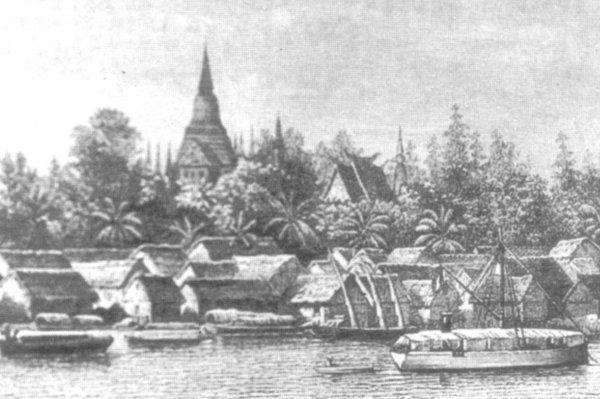Phnom Penh -
The
Heart of the Kingdom
Phnom Penh City takes its name from the present Wat Phnom or Hill Temple. Conveniently located a 3 min walk from Eighty8. Legend has it that in 1372, an old nun named Penh went to fetch the water in the Mekong river and found a dead Koki tree floating down the stream. Inside the hole of that dead Koki tree contained four bronze and one stone Buddha statues in it.Daun Penh brought the statues ashore and ordered people to pile up earth at northeast of her house and used those Koki trunks to build a temple on that hill to house the five Buddha statues, then named the temple after her as Wat Phnom Daun Penh, which presently known as Wat Phnom, a small hill of 27 metres in height.
The city was originally called Phnom Daun Penh after it was founded, but it was later abbreviated to just Phnom Penh.
Phnom Penh: The Royal Capital of Cambodia
Phnom Penh first became the royal capital of Cambodia in 1432. Phnom Penh remained the royal capital for 73 years from 1432 to 1505. It was abandoned for 360 years from 1505 to 1865 by subsequent kings due to internal fighting between the royal pretenders. It was not until 1865 that Phnom Penh became the permanent royal capital of Cambodia when King Norodom I ordered 10,000 of his subjects to move out of the old royal capital of Oudong and settle back into Phnom Penh. It was then, in 1866 that the current Royal Palace was built.
1866 – 1927
Phnom Penh during the first ten years of king Norodom’s reign Phnom Penh was little more than a village with few huts lining the river.
Beginning in 1870, the French colonial administration had turned a sleepy village into a city when it started to build hotels, schools, prisons, barracks, bank, public works offices, telegraph offices, Law courts, and health services buildings. In 1872, the first glimpse of a modern city took shape when the colonial administration contracted a French contractor, Le Faucheur, to construct the first 300 concrete houses for sales and rentals.
In 1884, the colonial administrator commissioned the constructions of underground sewage systems, canals to control the wetlands and roads, buildings and a port were also constructed.
In 1893, Wat Phnom park had been rehabilitated and a zoo was built, surrounded by gardens. In 1895, CEEL, the first French company that produced clean water for Phnom Penh, built its first water plant at Chroy Changva.
1927-1941
In this period, Phnom Penh saw some major infrastructure construction improvements. In 1928, a French company, Grands Travaux de Marseille, had been contracted to begin pumping sands from the bottom of Tonle Sap River to fill up Decho lake and other lakes in the city. The year of 1929 also saw a construction of a steel Preah Monivong Bridge.
In 1932, the first railway tracts and stations from Phnom Penh to Battambang had been commissioned.
In 1935, the Grand Market was built. And in 1939, Verdun Avenue, now renamed Blvd. J. Nerhu and Ave. Preah Sihanouk was built.
1939-1970
In this timeframe the city’s population was to grow dramatically. The city’s population had grown to 111,000 in 1942. By 1950 it had grown to 354,000 and 355,000 in 1958. By 1962, the population of Phnom Penh City reached 394,000. To help balance out this population growth, a new flashy modern suburb was constructed in 1961 called Tuol Kork.
Other infrastructures had also been built during this period. The International Olympic Stadium was built in 1963. In 1964, Tonle Bassac Theater and a Casino, were constructed. A railway line from Phnom Penh to Sihanoukville was also commissioned in 1964. The International Airport of Pochentong was also built. And in 1966, the Sangkum Reah Niyum Bridge was built with funds provided by Japan. Gardens and parks were constructed and beautified. Phnom Penh City in the 1960s was called the Pearl of Asia.
Phnom Penh during the Khmer Republic of Marshall Lon Nol: 1970-1975
Phnom Penh from 1970 onward had not seen much developments due to the Cambodian civil war. The original population of Phnom Penh City of 900,000 had swelled to over 2,000,000 at the end of the war in 1975 because of war refugees from the countryside.
On the contrary, many infrastructures had been destroyed by fighting and shells. In 1973, the Khmer Rouge mined Chroy Changvar Bridge two times which eventually destroyed it.
Phnom Penh during the Khmer Rouge Reign of Terror: 1975-1979
The Khmer Rouge took power on 17th April 1975 and immediately began to evacuate whole population out of the city. In three days, a city with a population of 2,000,000 had been reduced to a population of a few Khmer Rouge officials. Many infrastructures and buildings and part of the city had been significantly destroyed.
1979-Present Day
After the Vietnamese troops toppled the Khmer Rouge on 5th January 1979, the population began to return to Phnom Penh. As of 1998, the population of Phnom Penh City had numbered to 862,000 people, including 149,000 families. In 2009, the population of Phnom Penh is estimated to number more than a one million.
Phnom Penh today is a city that is rich in history and culture. Although a capital city, the essence of Phnom Penh is one that holds true to Cambodians values and way of life close to heart.



No comments:
Post a Comment